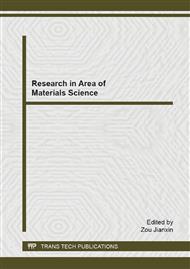p.50
p.54
p.62
p.69
p.76
p.80
p.89
p.93
p.98
Influence of Annealing Temperature on the Properties of Zn-Sb Composite Thin Films by Magnetron Sputtering
Abstract:
Zn-Sb based composite thin films have been prepared by radio frequency magnetron sputtering using a Zn4Sb3 compound target followed by thermal annealing. Sample structure and surface morphology were analyzed by X-ray diffraction (XRD) and atomic force microscopy (AFM). The electrical properties of the films were studied by Hall measurements. The X-ray diffraction patterns reveal that the intensity of diffraction peak of ZnSb phase is enhanced as temperature increasing. Results of AFM shows the rms roughness is getting big with increasing temperature due to the growing crystal grains. Hall measurements indicate that the Zn-Sb composite thin films annealed at different temperatures are p-type conducting with carrier concentrations being on the order of 1019 cm-3.
Info:
Periodical:
Pages:
76-79
Citation:
Online since:
April 2015
Authors:
Keywords:
Price:
Сopyright:
© 2015 Trans Tech Publications Ltd. All Rights Reserved
Share:
Citation:


